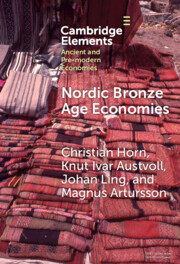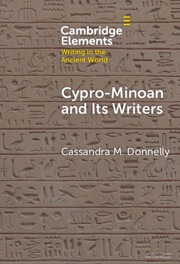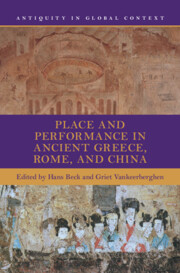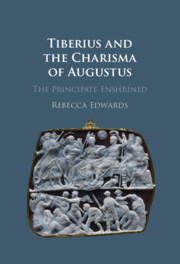Refine search
Actions for selected content:
23916 results in Ancient history
Chapter 9 - Hydropolitical Engineering in Rome and Chang’an
- from Part III - Urban Places
-
-
- Book:
- Place and Performance in Ancient Greece, Rome, and China
- Published online:
- 28 November 2024
- Print publication:
- 05 December 2024, pp 297-317
-
- Chapter
- Export citation
Chapter 2 - Local Administration, History, and Geography in the Han and Roman Empires
- from Part I - Crafting Space and Place
-
-
- Book:
- Place and Performance in Ancient Greece, Rome, and China
- Published online:
- 28 November 2024
- Print publication:
- 05 December 2024, pp 59-86
-
- Chapter
- Export citation
Editors’ Preface
-
- Book:
- Place and Performance in Ancient Greece, Rome, and China
- Published online:
- 28 November 2024
- Print publication:
- 05 December 2024, pp xii-xiv
-
- Chapter
- Export citation
Part II - Performances of Power
-
- Book:
- Place and Performance in Ancient Greece, Rome, and China
- Published online:
- 28 November 2024
- Print publication:
- 05 December 2024, pp 87-238
-
- Chapter
- Export citation
Copyright page
-
- Book:
- Place and Performance in Ancient Greece, Rome, and China
- Published online:
- 28 November 2024
- Print publication:
- 05 December 2024, pp iv-iv
-
- Chapter
- Export citation

Nordic Bronze Age Economies
-
- Published online:
- 03 December 2024
- Print publication:
- 19 December 2024
-
- Element
-
- You have access
- Open access
- HTML
- Export citation

Cypro-Minoan and Its Writers
- At Home and Overseas
-
- Published online:
- 01 December 2024
- Print publication:
- 02 January 2025
-
- Element
- Export citation

Place and Performance in Ancient Greece, Rome, and China
-
- Published online:
- 28 November 2024
- Print publication:
- 05 December 2024

Tiberius and the Charisma of Augustus
- The Principate Enshrined
-
- Published online:
- 28 November 2024
- Print publication:
- 28 November 2024
Contents
-
- Book:
- Tiberius and the Charisma of Augustus
- Published online:
- 28 November 2024
- Print publication:
- 28 November 2024, pp v-v
-
- Chapter
- Export citation
Chapter 3 - Charismatic Precedents
-
- Book:
- Tiberius and the Charisma of Augustus
- Published online:
- 28 November 2024
- Print publication:
- 28 November 2024, pp 66-97
-
- Chapter
- Export citation
Conclusions
-
- Book:
- Tiberius and the Charisma of Augustus
- Published online:
- 28 November 2024
- Print publication:
- 28 November 2024, pp 207-209
-
- Chapter
- Export citation
Acknowledgements
-
- Book:
- Tiberius and the Charisma of Augustus
- Published online:
- 28 November 2024
- Print publication:
- 28 November 2024, pp vii-viii
-
- Chapter
- Export citation
Introduction
-
- Book:
- Tiberius and the Charisma of Augustus
- Published online:
- 28 November 2024
- Print publication:
- 28 November 2024, pp 1-6
-
- Chapter
- Export citation
Chapter 5 - Charismatic Images of Augustus in Tiberian Authors
-
- Book:
- Tiberius and the Charisma of Augustus
- Published online:
- 28 November 2024
- Print publication:
- 28 November 2024, pp 135-165
-
- Chapter
- Export citation
Chapter 1 - Augustan Charisma and Its Transfer
-
- Book:
- Tiberius and the Charisma of Augustus
- Published online:
- 28 November 2024
- Print publication:
- 28 November 2024, pp 7-35
-
- Chapter
- Export citation
Bibliography
-
- Book:
- Tiberius and the Charisma of Augustus
- Published online:
- 28 November 2024
- Print publication:
- 28 November 2024, pp 210-237
-
- Chapter
- Export citation
Index
-
- Book:
- Tiberius and the Charisma of Augustus
- Published online:
- 28 November 2024
- Print publication:
- 28 November 2024, pp 238-242
-
- Chapter
- Export citation
Copyright page
-
- Book:
- Tiberius and the Charisma of Augustus
- Published online:
- 28 November 2024
- Print publication:
- 28 November 2024, pp iv-iv
-
- Chapter
- Export citation
Chapter 4 - The Power of Images of Augustus in the Age of Tiberius
-
- Book:
- Tiberius and the Charisma of Augustus
- Published online:
- 28 November 2024
- Print publication:
- 28 November 2024, pp 98-134
-
- Chapter
- Export citation
